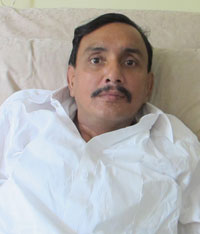Ali Jamshad - ALS (Pakistan) Posted on July 7,2014
Name: Ali Jamshad 
Sex: Male
Country: Pakistan
Age:44 years
Diagnosis: Amyotrophic lateral sclerosis
Date:June 16, 2014
Days Admitted to Hospital: 14 days
Before treatment:
The patient suffered from weakness and muscle atrophy of his left upper limb 5 years ago without obvious inducement. Then the patient had weakness of his right upper limbs and also developed neck pains. He was diagnosed with cervical spondylosis. The treatment effect was not good. The weakness and muscle atrophy of both upper limbs was aggravated gradually. His lower limbs were atrophied too in 2011. This also caused damage to his face, scapular region, trunk and four limbs. He was unable to finish part of his daily life activities. The electromyography at a hospital showed he had motor neuron disease. He took Riluzole for treatment, but there was no effect. The disease aggravated gradually. The patient had swallowing difficulty and chewing difficulty from 6 months ago.
From the onset of disease, the patient had good spirit. He had difficulty in swallowing and chewing difficulty too and only could eat liquid diet. The sleep quality was good. The defecation was normal. The patient couldn't turn over, sit-up, stand up or walk. He couldn't brush his teeth or comb his hair. There was no genetic disorders.
Admission PE:
Bp: 120/74mmHg; Hr: 74/min, temperature 36.6 deg. Br: 25/min. He could be in supine position in bed. The breathing movement of both lungs was weak. The respiratory sounds in both lower lungs were weak, with obvious rales. The rhythm of his heartbeat was normal, with no obvious murmur in the valves. His abdomen was flat and soft, with no pressing pain or rebound tenderness in the abdomen. The liver and the spleen were not enlarged. There was no swelling in both lower limbs.
Nervous System Examination:
Jamshad Ali was alert and was in good spirits. His speech was unclear. His memory, calculation abilities and orientation were all normal. Both pupils were equal in size, the diameter was 3mms. Both eyeballs could move flexibly and the pupils reacted normally to light stimulus. The forehead wrinkle pattern was symmetrical. He was able to close his eyes with ease. The bilateral nasolabial sulcus was equal in depth. He had weak muscle to drum his cheeks. He had difficulty to stretch his tongue. There was no obvious atrophy in the tongue. The movement of the tongue was flexible. He showed his teeth without deflection. He was able to raise his soft palate and the muscle strength of the soft palate was weak. He had swallowing difficulty. The neck was soft. He had weak muscles to raise and turn his head. The muscle strength to shrug his shoulders was at level 2. There was obvious muscle atrophy in his face, four limbs and trunk. And the face, shoulders, regio scapularis, both upper limbs and hands were more severe. The muscle strength of both upper limbs was at level 0. The hold power of both hands was at level 0. The muscle strength of both lower limbs was at level 1. The muscle tone of his four limbs was low. Bilateral tendon reflex could be elicited, other tendon reflex couldn't be elicited. Bilateral abdominal reflex disappeared. Bilateral palm jaw reflex were positive. Bilateral Hoffmann sign was negative. Bilateral Babinski sign was negative. The deep sensation and shallow sensation were normal. He was unable to finish the finger-to-nose test, fingers coordinate movement test, the rapid rotation test and the heel-knee-shin test. There were no signs of meningeal irritation. EMG examination showed lesions in the limbs were neural source lesions. The motor neuron disease was considered.
Treatment:
We initially gave Jamshad Ali a complete examination. He was diagnosed with Amyotrophic lateral sclerosis. He received treatment for nerve regeneration and to activate stem cells in vivo. At the same time, he received treatment to improve his blood circulation in order to increase the blood supply to the damaged neurons and to nourish them. He received Non-invasive ventilator for breath. This was accompanied by daily physical rehabilitation training.
Post treatment:
The patient's condition has improved. His speech is clearer than before. He can drum his cheeks slightly. He can stretch his tongue out of the teeth. The muscle strength to raise soft palate is strong and symmetrical. The swallowing difficulty alleviated. He breathe better. Br: 20/min. The thorax can expand larger than before. There is no breathing difficulty in horizontal position. The breath sounds are clear in both lungs' bottom. The muscle strength of his four limbs has improved. The muscle strength of both upper limbs is at level 1. The muscle strength of both lower limbs is at level 2.
